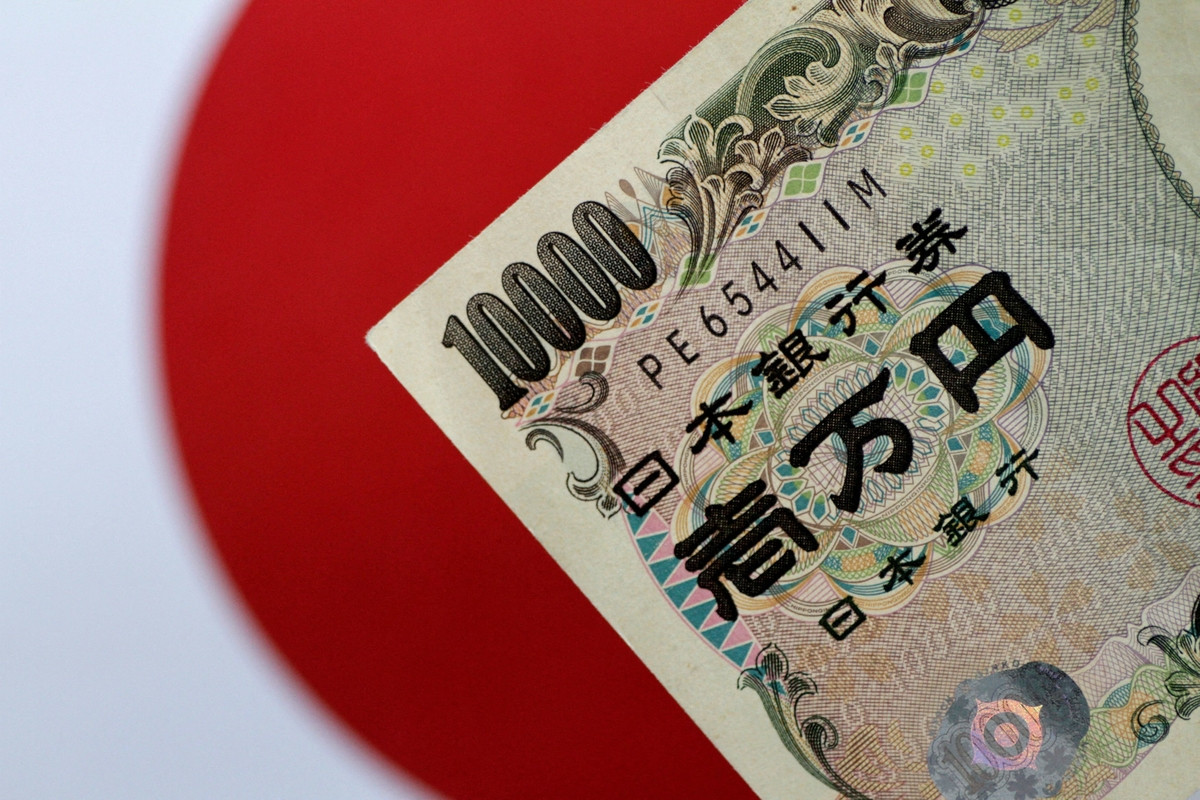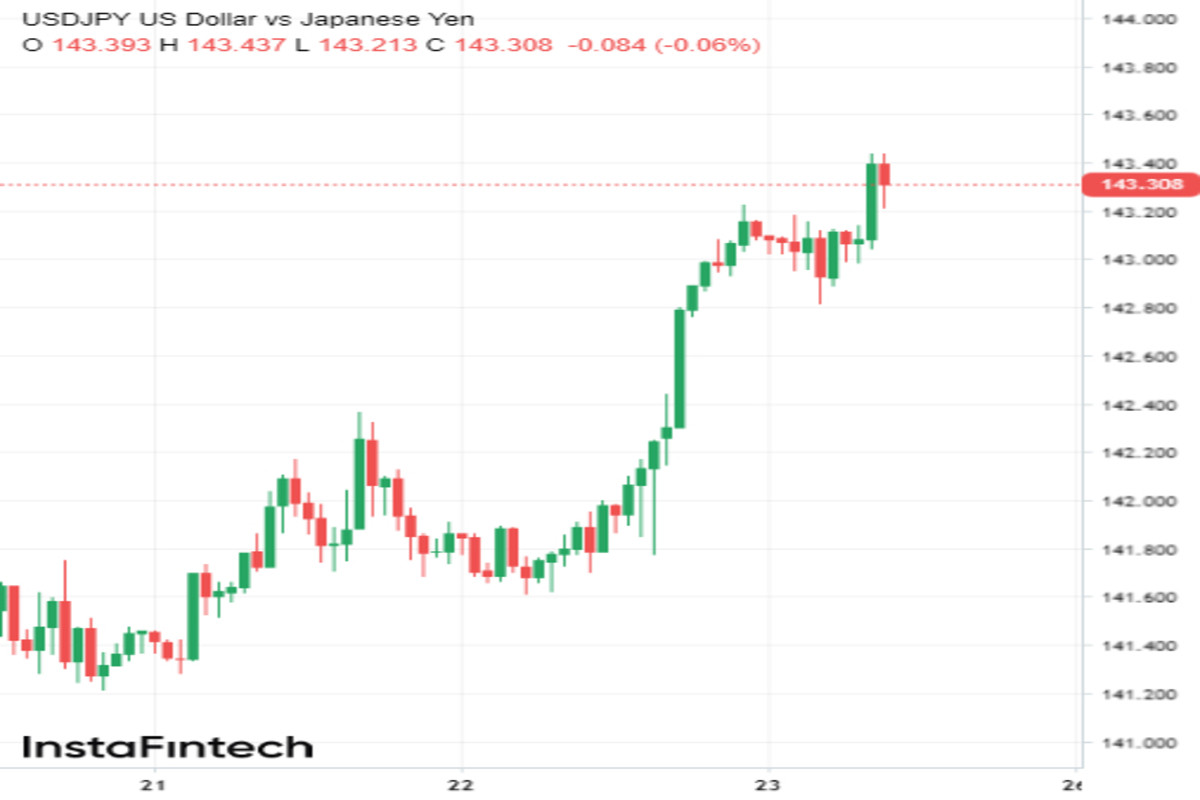
The Japanese currency continues to plummet at a rapid pace. Yesterday, the USD/JPY pair surged by 0.9%, reaching a new yearly high of 143.12. Will the pair manage to hold at this level and soar even higher? Or could something hinder its ambitious plans?
Positive scenario
Yesterday's surge of the US dollar against the yen was highly predictable. The Bank of Japan (BOJ) continues to send dovish signals to traders, while the Federal Reserve (Fed) clearly indicates that the June pause in rate hikes does not mean the end of the tightening cycle.
Speculation among investors regarding the potential divergence in monetary policies between Japan and the United States intensified in the past week, igniting the market with renewed force. This led to intensive buying of the USD/JPY pair, which has risen by over 2% since Monday.

One of the main drivers for the pair on Wednesday was the release of BOJ meeting minutes for April. As revealed in the minutes, BOJ members demonstrated their traditional unanimity by deciding to maintain an ultra-loose monetary policy.
In June, the Bank of Japan once again confirmed its dovish stance by keeping interest rates extremely low and maintaining a zero yield on government bonds.
The regulator also made no changes to its Yield Curve Control (YCC) mechanism, although some market participants were hoping for a small yet significant hawkish step that could support the yen.
However, this week, the pressure on JPY intensified even further due to the dovish rhetoric of Japanese officials. On Wednesday, the head of the BOJ, Kazuo Ueda, confirmed his intention to continue an accommodative policy in the near future, despite sustained economic growth.
On the same day, a board member of the Bank of Japan, Seiji Adachi, made a similar statement. He emphasized the importance of maintaining the current course at this stage, as further inflationary growth remains contentious, and he ruled out the possibility of adjusting the yield curve control policy in July.
On Thursday, his colleague Asahi Noguchi added fuel to the fire. The official stated that he expects a slowdown in price growth in Japan to a level below the BOJ's 2% target in the near future as commodity prices begin to slow down. Low inflation is a significant argument for continuing the ultra-loose policy.
The dovish tone of Japanese officials is a strong catalyst for the USD/JPY pair. The hawkish statements by Federal Reserve Chairman Jerome Powell gave even more driving force for the pair bulls.
On Wednesday and Thursday, the head of the US central bank appeared before the US Congress to deliver a report on monetary policy and discuss its future prospects with legislators.
Speaking on Capitol Hill, Powell supported the need for further interest rate hikes in the United States, albeit at a cautious pace. He also added that he does not expect any rate cuts in the near future, at least until the country's inflation level drops below 2%.
As we can see, the Federal Reserve continues to maintain a hawkish stance. The prospect of further tightening provides strong tailwinds for the yield of US 10-year bonds and, consequently, for the USD/JPY pair.
If the Federal Reserve and the Bank of Japan follow through with what they have announced to the market in the foreseeable future, the dollar should strengthen further against the yen. The current overbought state of the asset might force bullish investors to pause in the short term, possibly leading to a downward correction in the USD/JPY pair.
However, considering the extremely favorable fundamental backdrop, it can be assumed that any intraday pullback will still be viewed as an excellent buying opportunity by some market participants. In this context, a corrective decline is likely to be very limited, and the overall trend will remain bullish over the next few weeks.
To enhance the dollar's upward momentum, a powerful impulse may be needed. This could potentially come from the forthcoming US inflation data release and the publication of June's Non-Farm Payrolls.
Negative scenario
Most analysts currently believe that the dollar/yen will continue to move upwards. However, let's not forget about the risks, especially since a major cause for concern has recently emerged.
On Friday morning, consumer price growth data for the previous month was published in Japan. The results were higher than expected, providing temporary support for the yen. Following the data release, the USD/JPY asset dropped below 143 before crossing this level once again.
In May, the headline CPI, which includes fresh food prices and energy, rose by 3.2% YoY, while economists had anticipated a rise of 3.1%. Meanwhile, the core inflation indicator, which excludes prices for fresh food and fuel and is a key barometer of price trends in Japan, rose last month to the highest level since June 1981, reaching 4.3%.
"The fact that core consumer inflation continues to accelerate and has been above the central bank's 2% target for 14 consecutive months, calls into question the BOJ's statement that the current price rise is temporary," noted Bloomberg analysts.
Experts believe that the latest inflation data increases the likelihood that the Bank of Japan will revise its price growth forecasts upwards in July. According to the latest BOJ consensus, made in April, Japanese officials expected a slowdown in core consumer inflation in the current fiscal year to 1.8%.
"Today's statistics instill confidence that the Bank of Japan will raise its inflation assessments next month, which may compel it to take the first step in a hawkish direction," shared Ichiyoshi Securities analyst Nobuyasu Atago.
A third of economists surveyed by Bloomberg now hold the same view. Some experts are confident that a sharp upward revision of inflation forecasts will lead to a correction of the yield curve control mechanism at the BOJ's July meeting.
If the Bank of Japan stops calling inflation "temporary," there will likely be renewed market speculation about the possible normalization of its monetary policy in the near future.
This could likely lead to a sharp and uncontrollable rise in the yield of 10-year Japanese government bonds beyond the set limit, similar to what happened in December of the previous year.
The bond market chaos at that time forced Japanese officials to make a correction to their YCC policy. A similar scenario could very well play out now.
Economists at CIBC Capital Markets warn that a change in the yield curve control policy in Japan could result in a sharp pullback of the USD/JPY pair from its current highs.
According to expert forecasts, the quote risks plunging to 130 in the third quarter and to 127 by the end of the year.





















